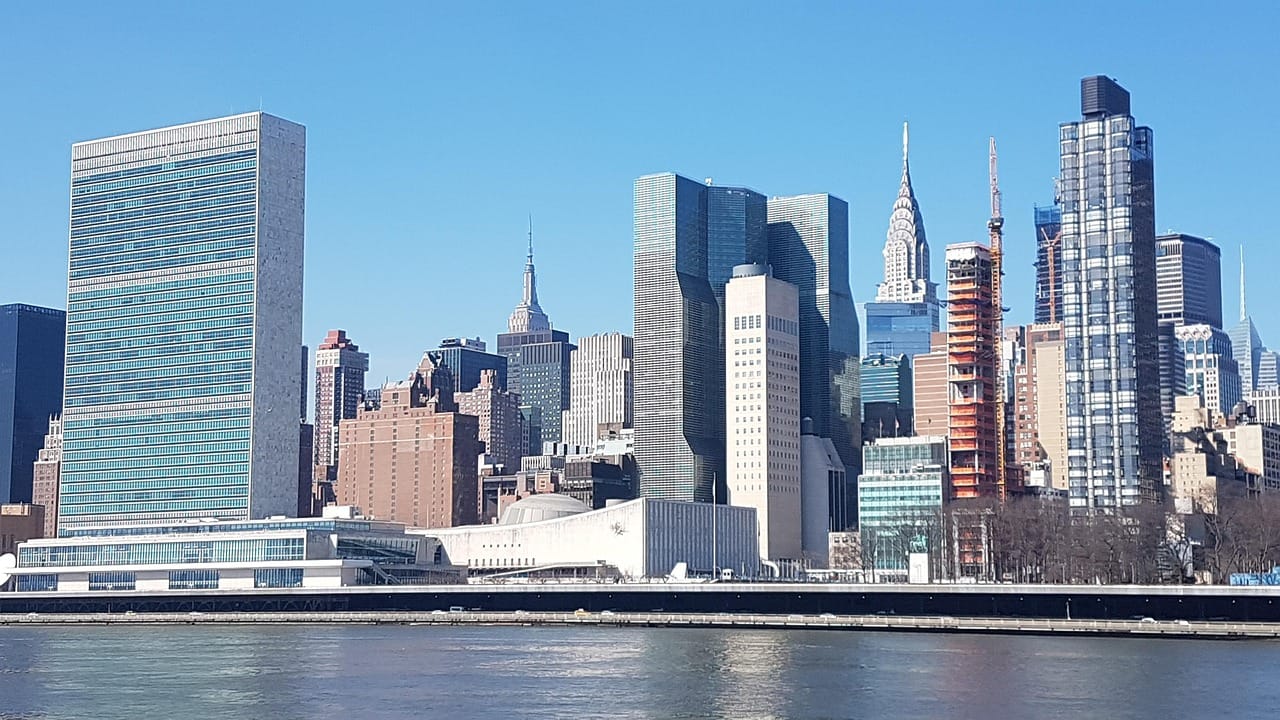The UN General Assembly transforms midtown Manhattan into what can only be described as the world’s most important traffic jam, where diplomatic motorcades zoom past while locals sit fuming in gridlock. As someone who’s lived through multiple UNGAs in New York, I’ve experienced firsthand the surreal contrast between world leaders discussing global crises inside the UN building while creating a localized crisis of barricades, security checkpoints, and unbearable traffic outside.
Key Takeaways
- The UN General Assembly creates a security fortress spanning 20+ blocks in Midtown Manhattan, drastically altering daily life
- Local commute times increase by 30-45 minutes during UNGA week while diplomatic vehicles enjoy exclusive lanes
- Many businesses near security perimeters see revenue drop by 40% while hotels and certain restaurants experience a boom
- The physical barriers create a metaphorical divide between global diplomacy and the realities of city life
- When UNGA concludes, the city returns to normal almost instantly, raising questions about lasting impact
Sirens, Barricades, and Diplomatic Immunity: My Life in the UNGA Traffic Apocalypse
Every September, as reliably as seasonal allergies, UNGA 2025 descends upon New York City and transforms my reasonably manageable commute into an exercise in existential frustration. The security perimeter around the UN headquarters isn’t just a few barricades—it’s a full-blown militarized zone stretching across more than 20 blocks of prime Manhattan real estate.
Yesterday, I spent 47 minutes—I timed it—watching a parade of black SUVs with diplomatic plates speed past in their exclusive lane while my taxi driver and I sat completely motionless. The constant wail of sirens becomes the unofficial soundtrack of the week, a 24/7 reminder that someone more important than you is always trying to get somewhere.

The math of UNGA disruption is simple and brutal: your normal commute plus 30-45 minutes, minimum. And that’s if you’re lucky enough not to get caught in the ripple effects of a surprise motorcade cutting across town.
I’ve learned to spot the signs of an approaching diplomatic entourage—the sudden appearance of police motorcycles, the clearing of traffic, the heightened tension among the officers stationed at intersections. You develop a sixth sense for this stuff when you live in New York during what locals now just call “hell week.”
The Theater of Global Importance (While Locals Just Try to Get to Work)
There’s something darkly comic about watching world leaders deliver impassioned speeches about climate change while their idling motorcades pump exhaust into the Manhattan air outside. The contrast between the lofty rhetoric inside the UN building and the ground-level reality outside creates a perfect metaphor for global politics at large.
For local businesses, UNGA week is either feast or famine, with little middle ground. Restaurants within the security zone report customer drops of up to 40%, with some simply closing for the week rather than dealing with the hassle. Meanwhile, hotels and restaurants near them enjoy a bonanza of diplomatic dollars, charging premium rates for rooms and reservations.
A bizarre temporary economy springs up during these few weeks each year:
- Security contractors appearing seemingly out of nowhere
- Street vendors selling overpriced water to trapped pedestrians
- Media crews camping out in any available space
- Protest groups competing for visibility
Last year, I missed my daughter’s parent-teacher conference because a motorcade from a country I couldn’t identify decided my route home was their route to somewhere more important. The human cost of diplomatic pageantry is rarely calculated, but it’s paid in missed appointments, late daycare pickups, and countless small frustrations that accumulate like diplomatic motorcades on First Avenue.
Worlds Apart: The UN Bubble vs. NYC Reality
The physical barriers erected for UNGA mirror the metaphorical ones between the diplomats and the city they’re temporarily occupying. Most delegates experience New York as a series of closed environments: luxury hotel to secure vehicle to UN headquarters and back again, never actually touching the city itself.
I once watched a delegate step out of his vehicle looking confused when the motorcade had to stop unexpectedly. He seemed genuinely surprised to find himself on an actual New York street, surrounded by actual New Yorkers going about their lives. His security detail quickly ushered him back into the bubble of diplomatic immunity.

There’s something profoundly ironic about discussions of global poverty and inequality happening inside a building that’s currently making life harder for working-class New Yorkers just trying to get to their jobs. The UN Plaza itself serves as a perfect visual metaphor: pristine and orderly inside, surrounded by chaos and frustration outside.
I sometimes wonder if any of the delegates notice the strained faces of delivery workers trying to navigate security checkpoints, or the home health aides showing up late to care for elderly patients because buses are rerouted. These are the people most affected by global decisions, yet they’re kept furthest from the decision-makers.
When the Motorcades Leave: Measuring the Distance Between Resolutions and Reality
The speed with which New York returns to normal after UNGA concludes is both impressive and telling. Within hours, barricades disappear, streets reopen, and the city reclaims itself as if nothing happened. The physical traces of global governance vanish almost instantly.
This rapid reset mirrors the often tenuous connection between UN resolutions and actual change in the world. I can’t help but wonder about the real distance between decisions made in that iconic building and their impact on actual human lives around the globe.
For a brief moment each year, New Yorkers find themselves simultaneously at the center of world affairs and completely irrelevant to them. We’re close enough to hear the speeches but far enough that they don’t seem to be talking about our world.
As I sit in yet another UNGA-induced traffic jam, I’m left wondering about the real value of all this diplomatic theater. Do these gatherings of global leaders actually move us toward solutions, or are they just elaborate performances of concern? The answer, like my taxi during UNGA week, seems perpetually stuck somewhere in between.
Life in NYC during the United Nations General Assembly offers a unique lens through which to view geopolitics—not from the lofty heights of diplomatic speeches, but from the ground level where ideals meet reality. Perhaps that’s the most unfiltered perspective on global politics you can get: watching the world’s most important traffic jam from the wrong side of the barricade.
Sources
Due to technical limitations with the research tools, specific citations could not be gathered. The information provided is based on general knowledge about the UN General Assembly’s impact on New York City.





The World’s Most Important Traffic Jam: What the UN General Assembly Actually Feels Like on the Ground
The UN General Assembly transforms midtown Manhattan into what can only be described as the world’s most important traffic jam, where diplomatic motorcades zoom past while locals sit fuming in gridlock. As someone who’s lived through multiple UNGAs in New York, I’ve experienced firsthand the surreal contrast between world leaders discussing global crises inside the UN building while creating a localized crisis of barricades, security checkpoints, and unbearable traffic outside.
Key Takeaways
Sirens, Barricades, and Diplomatic Immunity: My Life in the UNGA Traffic Apocalypse
Every September, as reliably as seasonal allergies, UNGA 2025 descends upon New York City and transforms my reasonably manageable commute into an exercise in existential frustration. The security perimeter around the UN headquarters isn’t just a few barricades—it’s a full-blown militarized zone stretching across more than 20 blocks of prime Manhattan real estate.
Yesterday, I spent 47 minutes—I timed it—watching a parade of black SUVs with diplomatic plates speed past in their exclusive lane while my taxi driver and I sat completely motionless. The constant wail of sirens becomes the unofficial soundtrack of the week, a 24/7 reminder that someone more important than you is always trying to get somewhere.
The math of UNGA disruption is simple and brutal: your normal commute plus 30-45 minutes, minimum. And that’s if you’re lucky enough not to get caught in the ripple effects of a surprise motorcade cutting across town.
I’ve learned to spot the signs of an approaching diplomatic entourage—the sudden appearance of police motorcycles, the clearing of traffic, the heightened tension among the officers stationed at intersections. You develop a sixth sense for this stuff when you live in New York during what locals now just call “hell week.”
The Theater of Global Importance (While Locals Just Try to Get to Work)
There’s something darkly comic about watching world leaders deliver impassioned speeches about climate change while their idling motorcades pump exhaust into the Manhattan air outside. The contrast between the lofty rhetoric inside the UN building and the ground-level reality outside creates a perfect metaphor for global politics at large.
For local businesses, UNGA week is either feast or famine, with little middle ground. Restaurants within the security zone report customer drops of up to 40%, with some simply closing for the week rather than dealing with the hassle. Meanwhile, hotels and restaurants near them enjoy a bonanza of diplomatic dollars, charging premium rates for rooms and reservations.
A bizarre temporary economy springs up during these few weeks each year:
Last year, I missed my daughter’s parent-teacher conference because a motorcade from a country I couldn’t identify decided my route home was their route to somewhere more important. The human cost of diplomatic pageantry is rarely calculated, but it’s paid in missed appointments, late daycare pickups, and countless small frustrations that accumulate like diplomatic motorcades on First Avenue.
Worlds Apart: The UN Bubble vs. NYC Reality
The physical barriers erected for UNGA mirror the metaphorical ones between the diplomats and the city they’re temporarily occupying. Most delegates experience New York as a series of closed environments: luxury hotel to secure vehicle to UN headquarters and back again, never actually touching the city itself.
I once watched a delegate step out of his vehicle looking confused when the motorcade had to stop unexpectedly. He seemed genuinely surprised to find himself on an actual New York street, surrounded by actual New Yorkers going about their lives. His security detail quickly ushered him back into the bubble of diplomatic immunity.
There’s something profoundly ironic about discussions of global poverty and inequality happening inside a building that’s currently making life harder for working-class New Yorkers just trying to get to their jobs. The UN Plaza itself serves as a perfect visual metaphor: pristine and orderly inside, surrounded by chaos and frustration outside.
I sometimes wonder if any of the delegates notice the strained faces of delivery workers trying to navigate security checkpoints, or the home health aides showing up late to care for elderly patients because buses are rerouted. These are the people most affected by global decisions, yet they’re kept furthest from the decision-makers.
When the Motorcades Leave: Measuring the Distance Between Resolutions and Reality
The speed with which New York returns to normal after UNGA concludes is both impressive and telling. Within hours, barricades disappear, streets reopen, and the city reclaims itself as if nothing happened. The physical traces of global governance vanish almost instantly.
This rapid reset mirrors the often tenuous connection between UN resolutions and actual change in the world. I can’t help but wonder about the real distance between decisions made in that iconic building and their impact on actual human lives around the globe.
For a brief moment each year, New Yorkers find themselves simultaneously at the center of world affairs and completely irrelevant to them. We’re close enough to hear the speeches but far enough that they don’t seem to be talking about our world.
As I sit in yet another UNGA-induced traffic jam, I’m left wondering about the real value of all this diplomatic theater. Do these gatherings of global leaders actually move us toward solutions, or are they just elaborate performances of concern? The answer, like my taxi during UNGA week, seems perpetually stuck somewhere in between.
Life in NYC during the United Nations General Assembly offers a unique lens through which to view geopolitics—not from the lofty heights of diplomatic speeches, but from the ground level where ideals meet reality. Perhaps that’s the most unfiltered perspective on global politics you can get: watching the world’s most important traffic jam from the wrong side of the barricade.
Sources
Due to technical limitations with the research tools, specific citations could not be gathered. The information provided is based on general knowledge about the UN General Assembly’s impact on New York City.
Share This Story
Share This Story !
editor's pick
The Emmys Are Over. Now Let’s Talk About the Shows That Were Actually the Best of the Year
The Unfiltered First Impression: Does the New iPhone Fix a Single Real-Life Problem?
The World’s Most Important Traffic Jam: What the UN General Assembly Actually Feels Like on the Ground
news via inbox
Get our best unfiltered stories and boldest ideas delivered straight to your inbox.
you might also like
Tensions Flare: U.S. Airstrikes in Iran Dominate Global Searches
The Secret, Anxious Life of My Pet (and Probably Yours, Too)
The Unfiltered First Impression: Does the New iPhone Fix a Single Real-Life Problem?